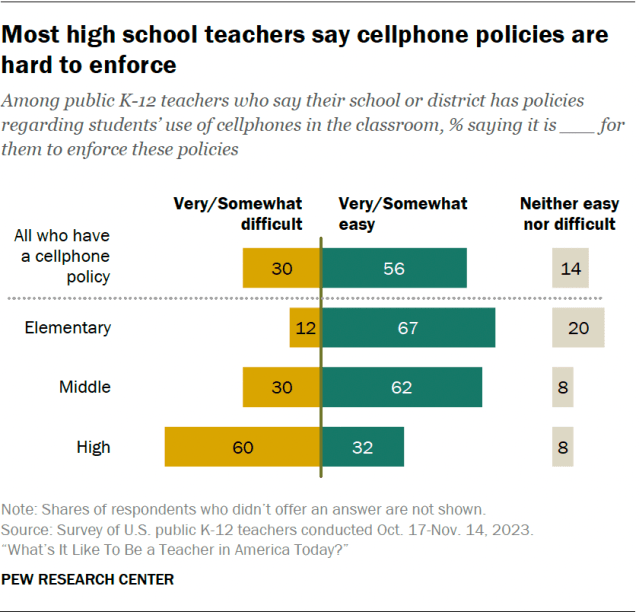In addition to asking public K-12 teachers about issues they see at their school, we asked how much each of the following is a problem among students in their classroom:
- Showing little to no interest in learning (47% say this is a major problem)
- Being distracted by their cellphones (33%)
- Getting up and walking around when they’re not supposed to (21%)
- Being disrespectful toward the teacher (21%)

Some challenges are more common among high school teachers, while others are more common among those who teach elementary or middle school.
- Cellphones: 72% of high school teachers say students being distracted by their cellphones in the classroom is a major problem. A third of middle school teachers and just 6% of elementary school teachers say the same.
- Little to no interest in learning: A majority of high school teachers (58%) say students showing little to no interest in learning is a major problem. This compares with half of middle school teachers and 40% of elementary school teachers.
- Getting up and walking around: 23% of elementary school teachers and 24% of middle school teachers see students getting up and walking around when they’re not supposed to as a major problem. A smaller share of high school teachers (16%) say the same.
- Being disrespectful: 23% of elementary school teachers and 27% of middle school teachers say students being disrespectful toward them is a major problem. Just 14% of high school teachers say this.
Policies around cellphone use
About eight-in-ten teachers (82%) say their school or district has policies regarding students’ use of cellphones in the classroom. Of those, 56% say these policies are at least somewhat easy to enforce, 30% say they’re difficult to enforce, and 14% say they’re neither easy nor difficult to enforce.

High school teachers are the least likely to say their school or district has policies regarding students’ use of cellphones in the classroom (71% vs. 84% of elementary school teachers and 94% of middle school teachers).
Among those who say there are such policies at their school, high school teachers are the most likely to say these are very or somewhat difficult to enforce. Six-in-ten high school teachers say this, compared with 30% of middle school teachers and 12% of elementary school teachers.
Verbal abuse and physical violence from students

Most teachers (68%) say they have experienced verbal abuse from their students, such as being yelled at or verbally threatened. About one-in-five (21%) say this happens at least a few times a month.
Physical violence is far less common, but about one-in-ten teachers (9%) say a student is physically violent toward them at least a few times a month. Four-in-ten say this has ever happened to them.
Differences by school level
Elementary school teachers (26%) are more likely than middle and high school teachers (18% and 16%) to say they experience verbal abuse from students a few times a month or more often.
And while relatively small shares across school levels say students are physically violent toward them a few times a month or more often, elementary school teachers (55%) are more likely than middle and high school teachers (33% and 23%) to say this has ever happened to them.
Differences by poverty level
Among teachers in high-poverty schools, 27% say they experience verbal abuse from students at least a few times a month. This is larger than the shares of teachers in medium- and low-poverty schools (19% and 18%) who say the same.
Experiences with physical violence don’t differ as much based on school poverty level.
Differences by gender

Teachers who are women are more likely than those who are men to say a student has been physically violent toward them. Some 43% of women teachers say this, compared with 30% of men.
There is also a gender difference in the shares of teachers who say they’ve experienced verbal abuse from students. But this difference is accounted for by the fact that women teachers are more likely than men to work in elementary schools.
Addressing behavioral and mental health challenges
Eight-in-ten teachers say they have to address students’ behavioral issues at least a few times a week, with 58% saying this happens every day.
A majority of teachers (57%) also say they help students with mental health challenges at least a few times a week, with 28% saying this happens daily.
Some teachers are more likely than others to say they have to address students’ behavior and mental health challenges on a daily basis. These include:

- Women: 62% of women teachers say they have to address behavior issues daily, compared with 43% of those who are men. And while 29% of women teachers say they have to help students with mental health challenges every day, a smaller share of men (19%) say the same.
- Elementary and middle school teachers: 68% each among elementary and middle school teachers say they have to deal with behavior issues daily, compared with 39% of high school teachers. A third of elementary and 29% of middle school teachers say they have to help students with mental health every day, compared with 19% of high school teachers.
- Teachers in high-poverty schools: 67% of teachers in schools with high levels of poverty say they have to address behavior issues on a daily basis. Smaller majorities of those in schools with medium or low levels of poverty say the same (56% and 54%). A third of teachers in high-poverty schools say they have to help students with mental health challenges every day, compared with about a quarter of those in medium- or low-poverty schools who say they have this experience (26% and 24%).




